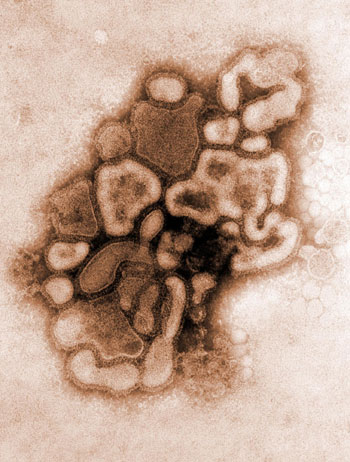Cordoba said Mexico has enough Tamiflu to treat 1 million people, but the medicine will be strictly controlled and handed out only by doctors.
Mexico's government had maintained until late Thursday that there was nothing unusual about the flu cases, although this year's flu season had been worse and longer than past years.
|

This colorized image from a transmission electron micrograph (TEM) depicts the A H1N1 "swine flu" virus from a previous outbreak in 1976, in an image released by the U.S. Centers for Disease Control (CDC), April 24, 2009. A deadly strain of flu never seen before has killed as many as 61 people in Mexico and has spread into the United States, where several people were reported ill. [Agencies]
|
The sudden turnaround by public health officials angered many Mexicans.
"They could have stopped it in time," said Araceli Cruz, 24, a university student who emerged from the subway wearing a surgical mask. "Now they've let it spread to other people."
The city was handing out free surgical masks to passengers on buses and the subway system, which carries 5 million people each day. Government workers were ordered to wear the masks, and authorities urged residents to stay home from work if they felt ill.
Closing schools across Mexico's capital of 20 million kept 6.1 million students home, as well as thousands of university students. All state and city-run cultural activities were suspended, including libraries, state-run theaters, and at least 14 museums. Private athletic clubs closed down and soccer leagues were considering canceling weekend games.
The closures were the first citywide shutdown of public gathering places since millions died in the devastating 1985 earthquake.
Mexico's response brought to mind other major outbreaks, such as when SARS hit Asia. At its peak in 2003, Beijing shuttered schools, cinemas and restaurants, and thousands of people were quarantined at home.
In March 2008, Hong Kong ordered more than a half-million students to stay home for two weeks because of a flu outbreak. It was the first such closure in Hong Kong since the outbreak of SARS, or severe acute respiratory syndrome.
"It's great they are taking precautions," said Lillian Molina, a teacher at the Montessori's World preschool in Mexico City, who scrubbed down empty classrooms with Clorox, soap and Lysol between fielding calls from worried parents.
US health officials said the outbreak is not yet a reason for alarm in the United States. The five people sickened in California and three in Texas have all recovered.
It's unclear how the eight, who became ill between late March and mid-April, contracted the virus because none were in contact with pigs, which is how people usually catch swine flu. And only a few were in contact with each other.
CDC officials described the virus as having a unique combination of gene segments not seen before in people or pigs. The bug contains human virus, avian virus from North America and pig viruses from North America, Europe and Asia. It may be completely new, or it may have been around for a while and was only detected now through improved testing and surveillance, CDC officials said.
The most notorious flu pandemic is thought to have killed at least 40 million people worldwide in 1918-19. Two other, less deadly flu pandemics struck in 1957 and 1968.

